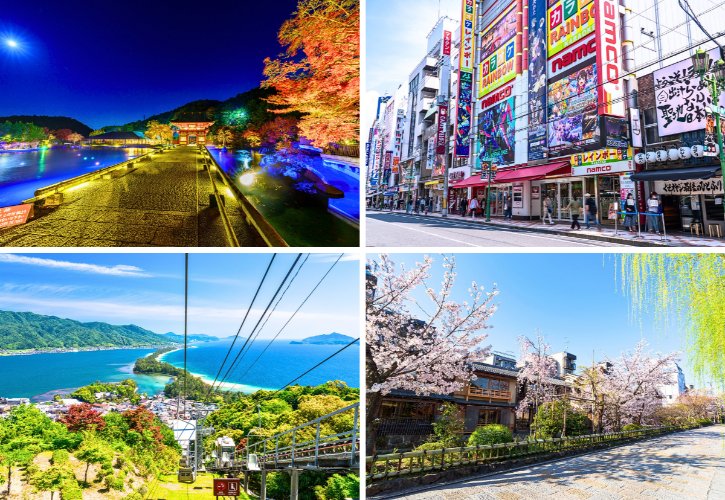
Ever wondered what lies beyond the crowded tourist spots in Osaka and Kyoto? I’ve discovered 10 amazing places where you can experience authentic Japan.
Stroll down lantern-lit alleys, pray at moss-covered statue, and find the perfect vintage manga in quirky shopping districts.
These special spots offer peaceful temples, stunning views, and delicious local foods that most visitors never see.
I hope this list helps you create unforgettable memories in Japan! 😊
1. Hozenji Yokocho (Osaka)
a. Overview
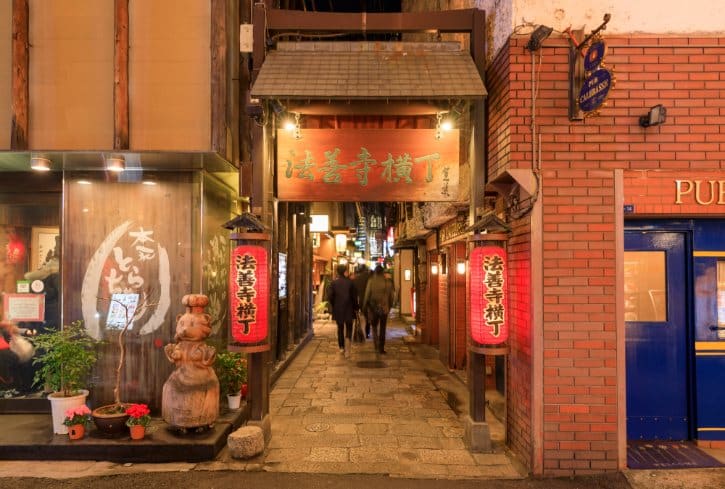
- What It Is: Hozenji Yokocho is a short, stone-paved alley in Osaka, close to Dotonbori, famous for traditional shops, eateries, and Hozenji Temple.
- History: Originally developed during the Edo Period as a gathering spot for worshippers visiting Hozenji Temple. After WWII destruction, locals rebuilt it, preserving its historic atmosphere.
- Why Visit: Experience historic Osaka charm, try delicious local foods, visit a unique moss-covered statue at Hozenji Temple, and enjoy a calm break from the busy city.
- Atmosphere: Quiet and calm during the day; lively and romantic in the evening with lanterns lighting the narrow alley.
b. What to Do There
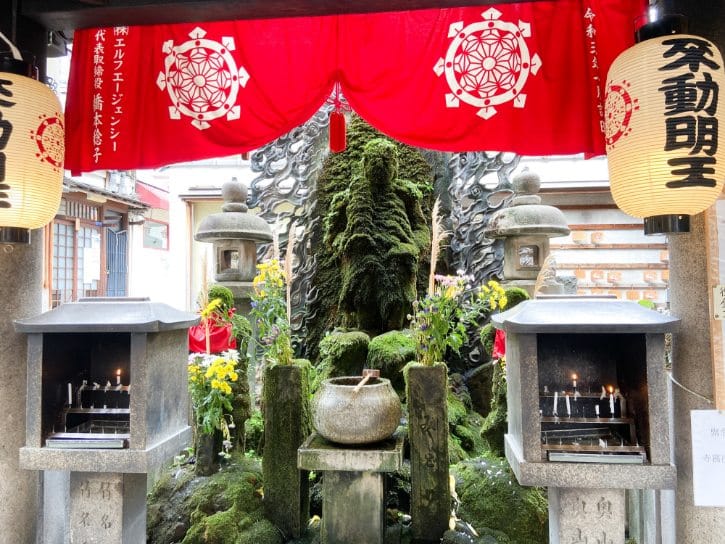
- Hozenji Temple
- Main Attraction: Famous for the “Mizukake Fudo” statue, a moss-covered Buddha that visitors splash with water for good luck.
- What to Do: Splash water gently over the statue with the ladles provided, and quietly make a wish or prayer for good luck.
- Recommended Tiny Bars and Cafes
- Arabia Coffee: Cozy retro cafe known for excellent coffee and tasty French toast, great for an afternoon break.
- Robatayaki Mizukake Chaya: Cozy bar where grilled dishes like scallops and vegetables are cooked over charcoal at the counter.
- Stroll the Alley
- Walk: Takes about 10 minutes, admire the lanterns and old-style buildings.
- When to Stroll: Evening (around sunset) is ideal for atmosphere and photos; early morning is peaceful and quiet.
c. Best Foods to Eat There
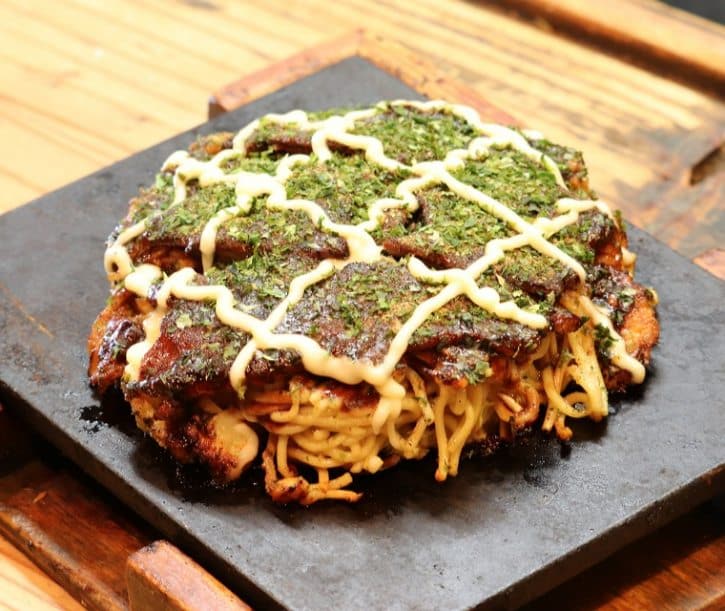
- Okonomiyaki (savory pancakes): Try at popular spots like Hozenji Sanpei or Yakizen, offering authentic local flavors.
- Kushikatsu (fried skewers): Eat at Kushikatsu Daruma; try skewered pork, shrimp, vegetables, and pair with beer. Remember: no double-dipping sauce.
- Katsudon (pork cutlet bowl): Katsudon Hozenji Yokocho serves delicious pork cutlets simmered with egg and onions over rice.
- Meoto Zenzai (sweet red bean soup): Famous dessert at Meoto Zenzai shop served in two bowls; symbolizes harmony for couples, but tasty solo too.
- Matsusaka Beef (premium wagyu beef): Matsusakagyu Yakiniku M serves high-quality grilled beef at table grills, reservations recommended.
d. How to Get There
- Option 1: Take the Osaka Metro Midosuji Line, Yotsubashi Line, or Sennichimae Line to Namba Station. Exit via Exit 14, then walk about 3 minutes to Hozenji Yokocho.
- Option 2: Take the Osaka Metro Sennichimae Line or Sakaisuji Line to Nippombashi Station. Exit via Exit 2, then walk about 5 minutes to Hozenji Yokocho.
Read More: 17 Best Street Foods to Try in Dotonbori Osaka
2. Sumiyoshi Taisha Shrine (Osaka)
a. Overview
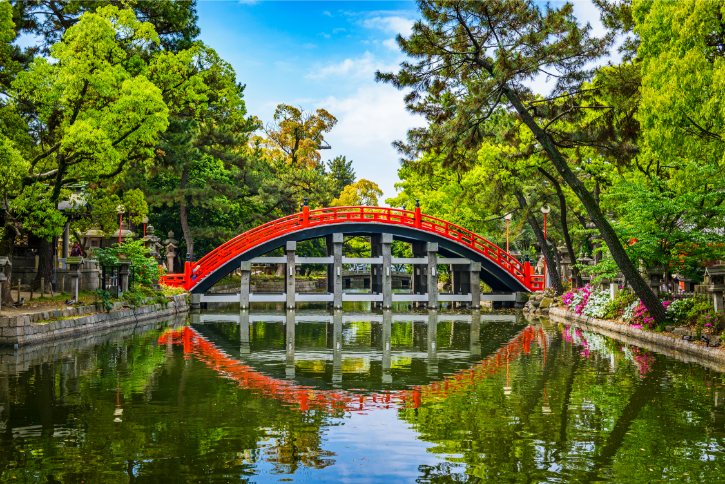
- What It Is: Sumiyoshi Taisha is a famous Shinto shrine in Osaka. It’s the main shrine of over 2,300 Sumiyoshi shrines across Japan.
- History: Founded about 2,000 years ago by Empress Jingū. It’s dedicated to sea gods protecting sailors and merchants, important for Osaka’s maritime history.
- Why Visit: Famous for its unique architecture (Sumiyoshi-zukuri), beautiful red arched bridge (Sorihashi), peaceful gardens, and special blessings for health, family, and good fortune.
- Atmosphere: Quiet, calm, and spiritual. It’s usually peaceful, except during festivals (especially New Year), when it gets crowded and lively.
b. Explore the Main Shrines
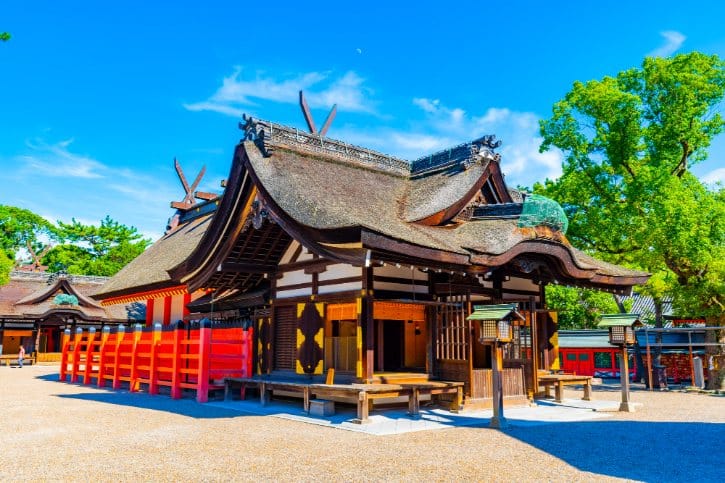
Main Shrines: Visit the four main shrine buildings (National Treasures). Each is dedicated to a different deity. You can pray by bowing twice, clapping twice, then bowing again.
c. Sub-Shrines for Special Blessings
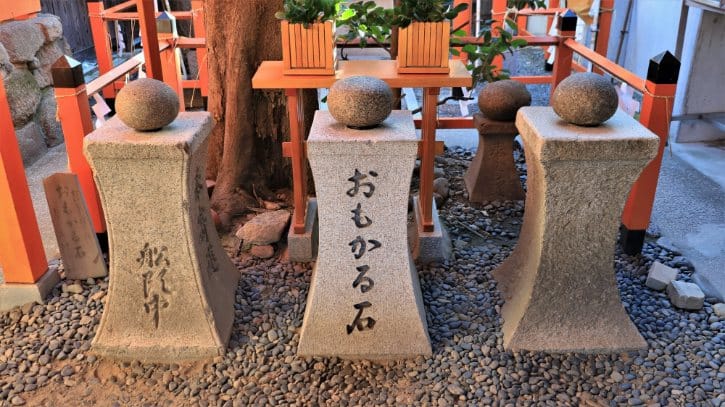
- Omokaru Ishi: Lift the “Omokaru stone” after making a wish. If it feels lighter than expected, your wish might come true.
- Nankun-sha: Visit this shrine for success in business and wealth.
- Tanekashi-sha: Popular for couples praying for fertility and having children.
- 1,000-Year-Old Camphor Tree: See the massive sacred tree that’s over a thousand years old, located near a smaller shrine called Nankun-sha. It’s a relaxing spot and great for photos.
d. Goshogozen Sacred Area
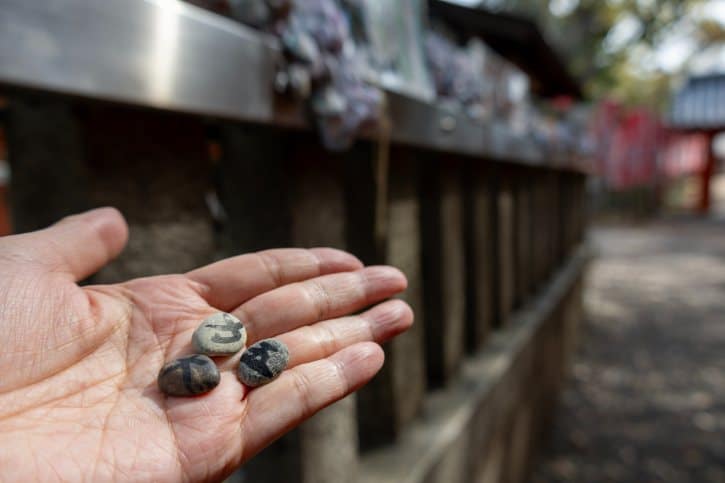
Goshogozen (Sacred Stone Area): Found near the main shrines. Look for small stones marked with the characters 五 (five), 大 (great), and 力 (power). Finding these stones is believed to bring luck, strength, wisdom, happiness, and prosperity.
e. Sorihashi Bridge
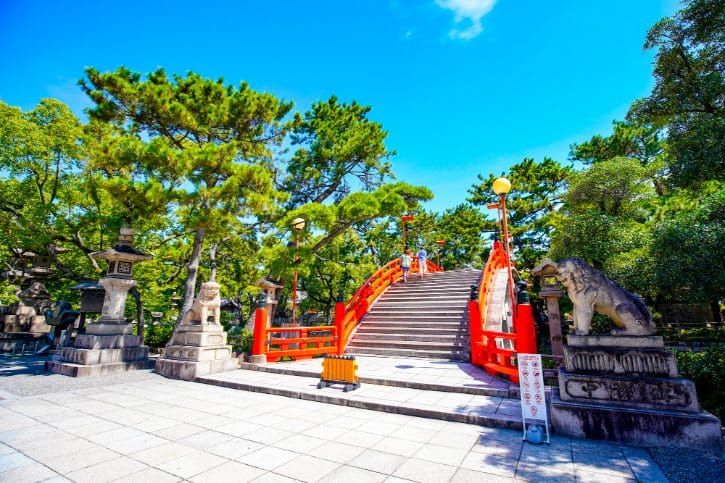
Cross the Sorihashi Bridge (Taiko-bashi): Cross the famous red arched bridge at the shrine’s entrance. Believed to cleanse bad luck and a perfect spot for photos.
f. How to Get There
- Option 1: Take the Nankai Main Line to Sumiyoshi Taisha Station. Exit via East Exit, then walk about 2 minutes to Sumiyoshi Taisha Shrine.
- Option 2: Take the Hankai Tramway’s Hankai Line to Sumiyoshitorii-mae Station, which is directly adjacent to Sumiyoshi Taisha Shrine. This route offers a charming tram experience.
Read More: Top 17 Things to Do in Osaka
3. Katsuoji Temple (Osaka)
a. Overview
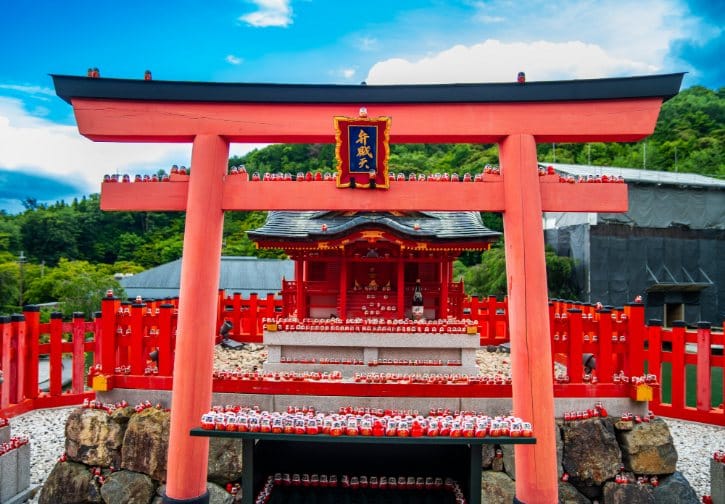
- What It Is: Katsuoji Temple is a historic Buddhist temple in the mountains of northern Osaka, known as the “Victory Temple”. People visit to pray for success and good luck.
- History: Founded about 1,300 years ago, originally built by monks and later named Katsuoji (“Temple of the Victorious King”) after prayers helped an emperor recover from illness.
- Why Visit: Famous for its thousands of red daruma dolls, symbolizing luck and perseverance. Visitors come to wish for success in exams, sports, career, or personal goals.
- Atmosphere: Calm, peaceful, and uplifting. Surrounded by forests, scenic ponds, bridges, and traditional temple buildings. Often misty, creating a quiet, spiritual feeling.
b. Activities and Rituals
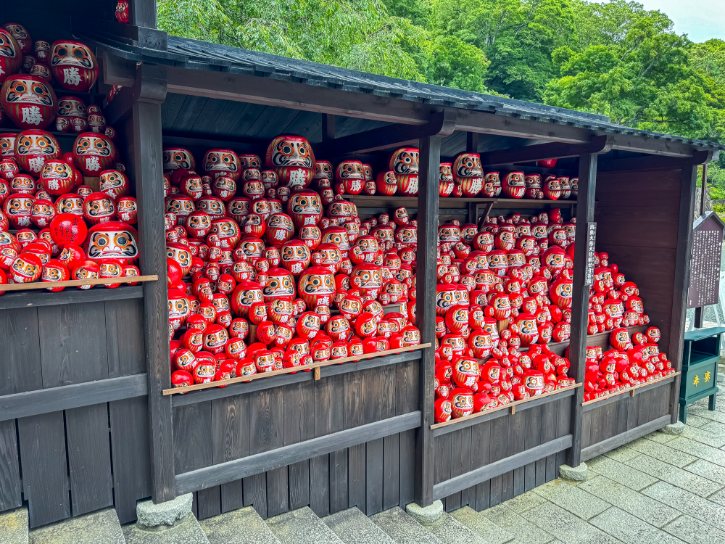
- Explore Daruma Dolls: Daruma dolls (red figures symbolizing perseverance) are placed throughout the temple. Spot these dolls in trees, on paths, and around the buildings.
- Participate in Rituals
- Throw a Coin: Toss a 5-yen coin (good fortune) or 50-yen coin (seeing the future clearly) into the offering box at the main hall and quietly say your prayer or wish.
- Light Incense: Light incense sticks afterward for extra blessings and good luck.
- Buy a Daruma Doll and Make a Wish: Purchase your own daruma doll, write your goal on it, color one eye now and the second eye once your goal is achieved.
- Get a Goshuin: Visit the temple office to get a special temple stamp (“goshuin”) in your stamp book or buy a book there if you don’t have one.
c. Seasonal Highlights

Enjoy Seasonal Scenery: Best seasons are spring (cherry blossoms in late March–April), summer (hydrangeas in June–July), and autumn (colorful autumn foliage in November).
d. Walk the Temple Grounds
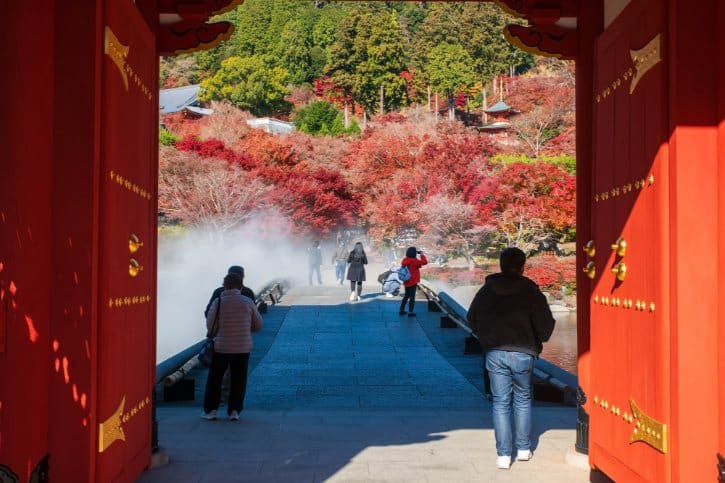
- Misty Bridge: Cross the bridge at the entrance over a scenic pond (Kannon Pond), often covered in mist.
- Main Hall: Climb stairs lined with daruma dolls, admire temple architecture, and enjoy great views.
- Pagoda and Paths: Visit the beautiful red pagoda and follow walking paths to discover statues, shrines, and gardens.
e. How to Get There
- Take the Osaka Metro Midosuji Line to Minoh-kayano Station.
- From Minoh-kayano Station, take Hankyu Bus #29 or Hankyu Bus #30 (Limited Express) to Katsuoji Temple bus stop (about 22 minutes, fare: ¥800).
- From the bus stop, walk about 1 minute to Katsuoji Temple.
- Buses run every 1 hour, so please check the schedule.
Read More: The Perfect 3-Day Osaka Itinerary for Tourists
4. Nipponbashi Denden Town (Osaka)
a. Overview
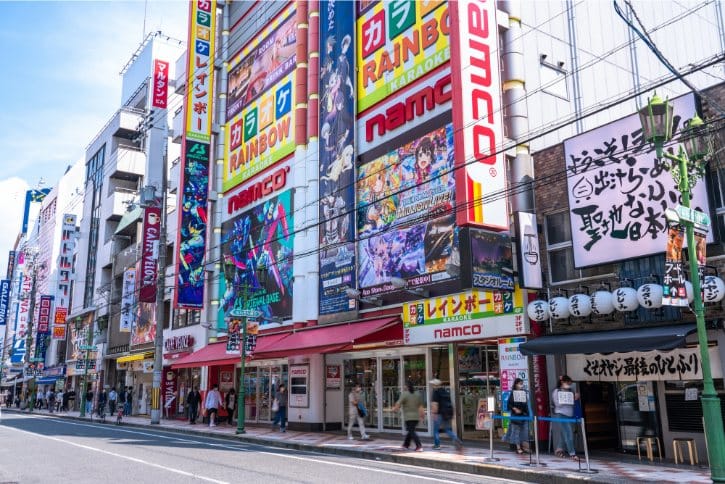
- What It Is: Nipponbashi Denden Town, also called “Den Den Town”, is Osaka’s district for anime, manga, video games, and electronics, similar to Akihabara in Tokyo.
- History: Originally famous for electronics after WWII, it later shifted focus to anime, manga, gaming, and hobby culture after big electronic stores opened elsewhere.
- Why Visit: Perfect if you love anime, manga, gaming, cosplay, or electronic gadgets. It’s great for shopping, finding rare collectibles, and enjoying Japanese pop culture.
- Atmosphere: Friendly, lively, and colorful, with anime and gaming themes everywhere. Less crowded than Akihabara, making it easier to explore and shop comfortably.
b. Shopping Highlights
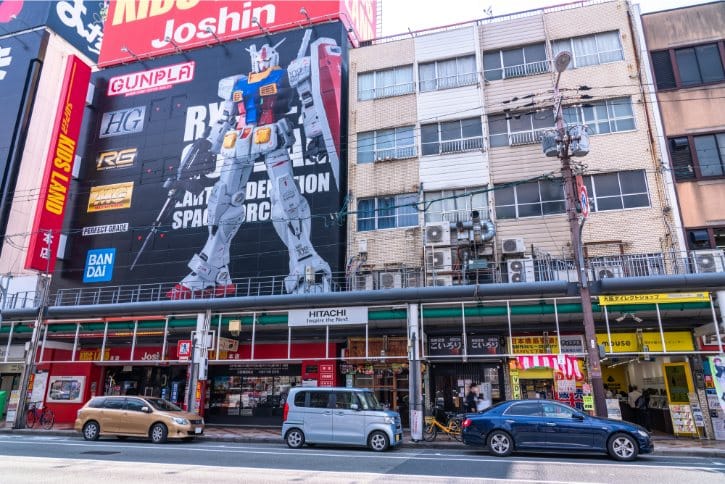
- Joshin Super Kids Land Main Store: Five-story store for Gundam kits, models, hobby toys, and collectibles.
- Animate Osaka Nipponbashi: Huge store selling anime merchandise, manga, DVDs, character goods, and collectibles.
- Mandarake: Famous second-hand store for rare manga, collectible figures, cosplay outfits, and anime merchandise.
- Super Potato: Popular store for retro video games, old consoles, and vintage gaming items like Nintendo and Sega games.
- Volks & Yellow Submarine: Model and hobby shops for Gundam kits, dolls, board games, card games, and collectibles.
c. Unique Experiences
- Maid Café (Maidreamin): Popular café where staff dressed as maids entertain you in a playful, themed environment, serving cute food and drinks.
- Play UFO Catchers (Taito Station): Try arcade claw machines filled with anime goods, plush toys, and fun prizes at multi-floor arcades.
- Cosplay on Otaku Road: Walk along the famous street where you’ll often see cosplayers, anime-themed cars (“itasha”), and plenty of stores selling costumes and anime goods.
- Gachapon Machines: Try capsule toy vending machines around the area for small, random anime or novelty items – fun souvenirs to bring home.
- Nipponbashi Street Festa (March): Big cosplay event held once a year (usually in March), where streets close for cosplay parades and festivities – perfect if your visit aligns.
d. How to Get There
- Option 1: Take the Osaka Metro Sakaisuji Line to Ebisucho Station. Exit via Exit 1A or 1B for direct access to Nipponbashi Denden Town.
- Option 2: Take the Osaka Metro Sakaisuji Line or Sennichimae Line to Nipponbashi Station. Exit via Exit 5 or 10, then walk about 5 minutes to Nipponbashi Denden Town.
5. Amerikamura (Osaka)
a. Overview
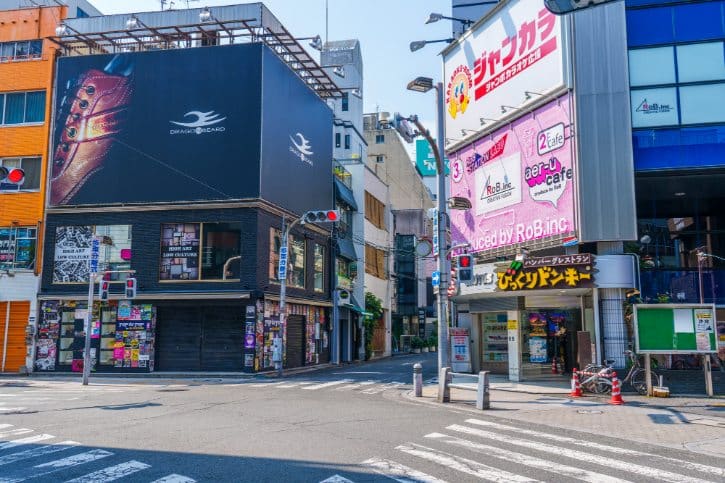
- What It Is: Amerikamura (or Amemura) is a lively, youth-oriented neighborhood near Shinsaibashi in Osaka, popular for street fashion, cool shops, cafes, and nightlife.
- History: Started in the 1960s selling American goods like secondhand clothes and records; evolved into Osaka’s center for youth culture, fashion trends, and creativity.
- Why Visit: Great place to experience Osaka’s youth culture, shop vintage or trendy items, taste local street food, and enjoy nightlife.
- Atmosphere: Casual, friendly, creative, and energetic. Lots of street art, fashion-forward locals, and a relaxed, inclusive vibe.
b. Food & Drinks
- Kogaryu (Takoyaki): Famous stand selling delicious, crispy-on-the-outside, soft-inside takoyaki; great for trying authentic local street food.
- Elk Pancake Café: Popular café serving fluffy, soufflé-style pancakes with sweet or savory toppings; cozy and perfect for brunch or dessert.
- LiLo Coffee Roasters: Third-wave coffee shop with high-quality coffee beans and friendly baristas; ideal for coffee lovers.
- Streamer Coffee Company: Trendy café known for specialty coffees like matcha espresso latte and latte art; good for hanging out.
- Ice Dog: Original Amerikamura snack of warm, fried buns filled with ice cream; tasty treat perfect for walking around.
c. Shopping
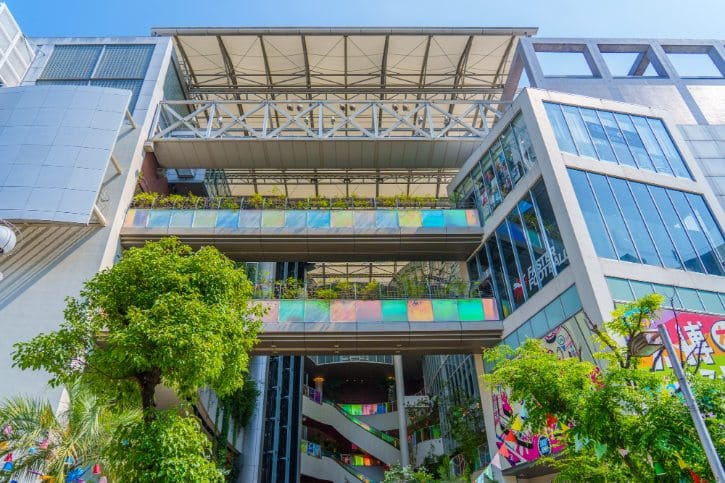
- Shinsaibashi Big Step: Multi-story shopping complex filled with diverse shops – vintage clothing, sneakers, cosplay items, records, and entertainment options.
- Kinji (Vintage Clothing): Large, affordable second-hand store inside Big Step offering vintage styles and unique fashion pieces.
- JAM (Vintage Store): Well-organized vintage shops specializing in American-style clothing (sportswear, retro jackets, jeans); great quality selections.
d. Sights & Experiences
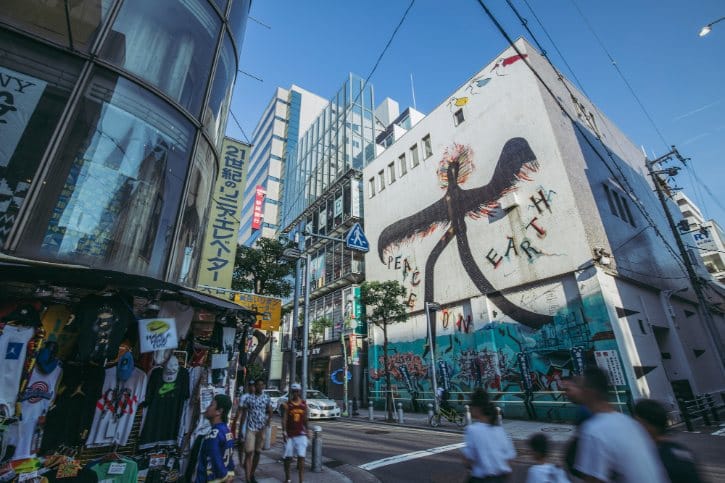
- Triangle Park (Sankaku Koen): Central hangout spot perfect for people-watching, seeing street performers, skaters, and local youth culture.
- Street Art & Murals: Explore murals and graffiti around the neighborhood, including the famous “Peace on Earth” mural; great for photography and experiencing local creativity.
e. How to Get There
- Option 1: Take the Osaka Metro Yotsubashi Line to Yotsubashi Station. Exit via Exit 5, then walk about 2 minutes to Amerikamura.
- Option 2: Take the Osaka Metro Midosuji Line or Nagahori Tsurumi-ryokuchi Line to Shinsaibashi Station. Exit via Exit 7, then walk about 5 minutes to Amerikamura.
6. Shirakawa Minami-dori (Kyoto)
a. Overview
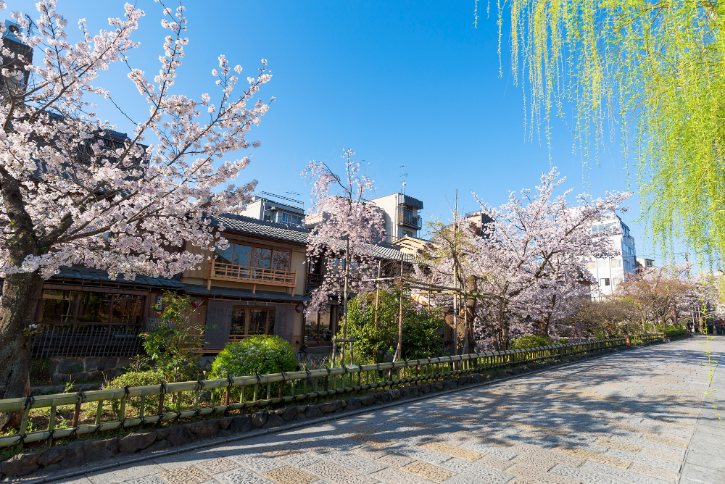
- What It Is: Shirakawa Minami-dori is a beautiful, quiet street along the Shirakawa Canal in Kyoto’s famous Gion district.
- History: Historically known for traditional tea houses where geisha performed, the area is now preserved as an important historical zone. Tatsumi Daimyojin Shrine here is dedicated to the goddess of arts and water.
- Why Visit: It’s one of Kyoto’s prettiest streets, known for cherry blossoms, traditional buildings, stone bridges, and a calm, authentic feel.
- Atmosphere: Peaceful, romantic, and traditional. It’s quieter than nearby areas, great for relaxed walks and enjoying Kyoto’s old-style charm.
b. Explore the Canal Area

- Walk Along the Canal & Tatsumi Bridge: Enjoy a relaxing stroll along the canal lined with willow and cherry trees. Tatsumi Bridge is a popular spot for beautiful photos.
- Visit Tatsumi Daimyojin Shrine: Small shrine popular with local geisha, dedicated to the goddess of art and water. You can briefly stop here, pray if you like, or simply enjoy its charm.
c. Enjoy Seasonal Views
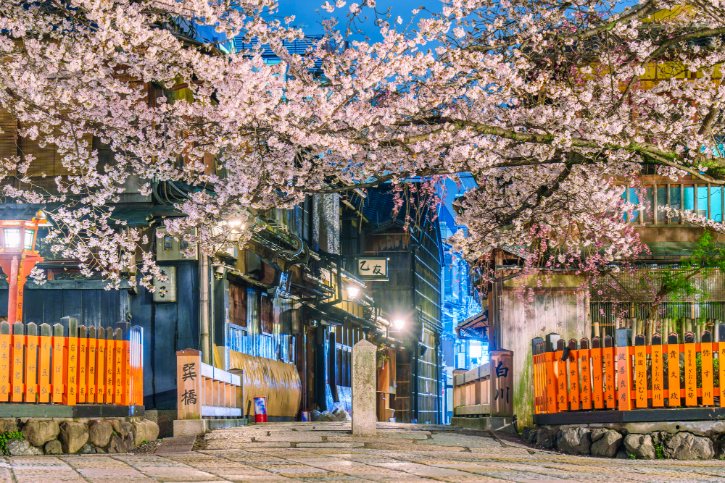
- Spring (March-April): Famous for cherry blossoms, especially beautiful early morning or in the evening. At night, the trees are lit up, creating a magical atmosphere.
- Autumn (November): Lovely colors, quieter than spring, with trees turning yellow and red. Great for peaceful walks.
- Winter (December-February): Quietest season, occasionally snowy, very peaceful. Great for photos and quiet atmosphere.
- Evenings: Charming at night when lanterns light up. Quieter after dark, with fewer people and a special ambiance.
d. Spot a Geisha or Maiko
- Timing: Best chance around 5:30–7:00 pm as they head to appointments, or around 9–10 pm when returning.
- Respectful Viewing: Watch quietly from a distance, don’t approach, touch, or disturb them.
e. Explore Nearby Gion Streets
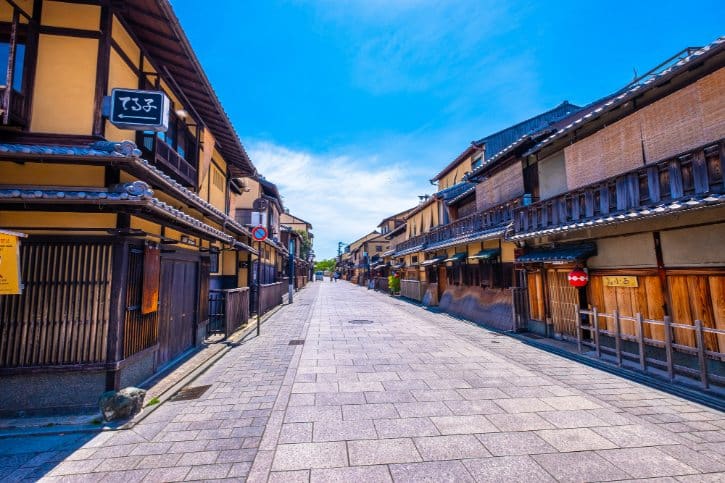
- Hanamikoji Street: Main geisha area, famous for traditional tea houses and restaurants, great for strolling and geisha sightings in early evening.
- Shijo-dori: Busy main street with shops, cafes, and easy access to public transport. Home to Yasaka Shrine and Minamiza Theatre, a useful area for shopping and transit.
f. How to Get There
- Option 1: Take the Keihan Main Line to Gion-Shijo Station. Exit via Exit 9, then walk about 3 minutes along Kawabata-dori to Shirakawa Minami-dori.
- Option 2: Take Kyoto City Bus #12, #31, #46, #58, #80, #201, #203, or #207 to Shijo Keihan-mae bus stop, then walk about 5 minutes to Shirakawa Minami-dori.
Read More: 10 Most Beautiful Places to Visit in Kyoto
7. Kodaiji Temple (Kyoto)
a. Overview
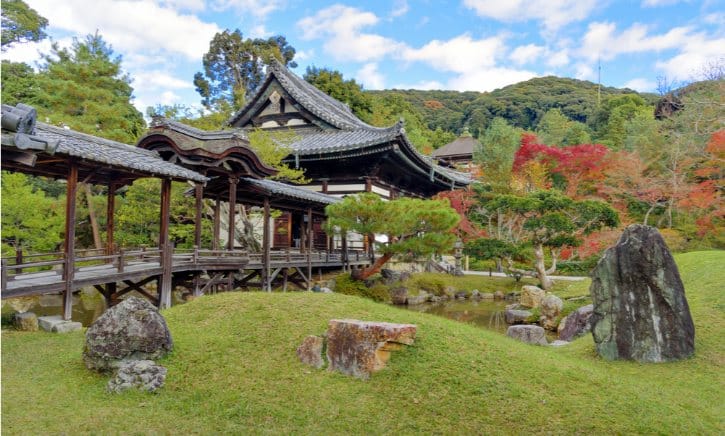
- What It Is: Kodaiji is a famous Zen Buddhist temple in Kyoto’s Higashiyama area, built in 1606 by Nene in honor of her husband, Toyotomi Hideyoshi. Hideyoshi was a powerful warlord who unified Japan in the late 16th century.
- History: Nene established Kodaiji after Hideyoshi’s death, with financial help from shogun Tokugawa Ieyasu. It became known for beautiful architecture, gardens, and artistic craftsmanship, especially its gold and lacquer decorations.
- Why Visit: You’ll experience beautiful gardens, historic buildings, traditional tea culture, and peaceful surroundings without huge crowds. It’s especially famous for spring cherry blossoms, autumn colors, and stunning evening illuminations.
- Atmosphere: Calm and peaceful. Gardens, traditional buildings, and nature combine for a relaxed, historical feel.
b. Explore the Gardens
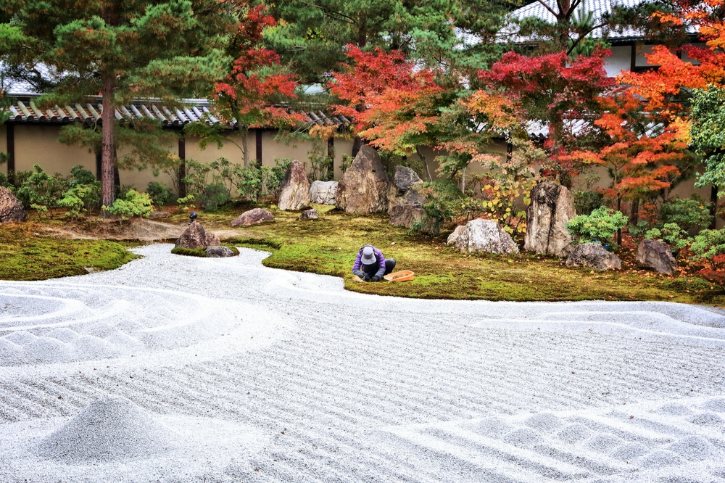
- Tsukiyama Garden: A scenic walking garden with a pond, hills, rocks, and seasonal plants. Beautiful cherry blossoms in spring and colorful maples in autumn.
- Rock Garden (Zen Garden): Dry gravel garden with raked patterns and rocks, designed for quiet viewing and contemplation. At night, it often features special lighting effects.
- Bamboo Grove: Small bamboo forest providing a peaceful and photogenic spot away from the main gardens.
c. Visit the Main Buildings
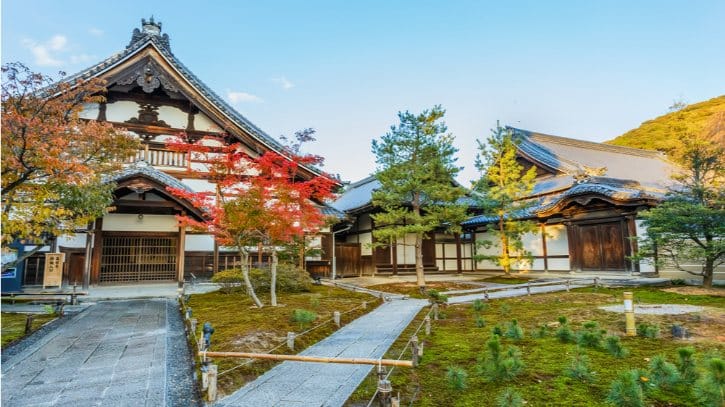
- Main Hall (Hojo): Central temple hall, rebuilt in 1912. Offers views over the Zen rock garden from the veranda.
- Kaisando (Founder’s Hall): Dedicated to the founding priest, featuring historical artwork and architecture from the 1600s.
- Otamaya (Sanctuary Hall): Mausoleum honoring Toyotomi Hideyoshi and Nene, famous for its beautiful gold lacquer decorations inside.
- Kangetsu-dai (Moon-Viewing Pavilion): Historic wooden corridor originally from Hideyoshi’s castle, ideal for viewing the moon and garden scenery.
d. Experience Tea Culture

- Historic Teahouses: See traditional tea huts like Kasa-tei and Shigure-tei, known for their simple, rustic designs.
- Tea Ceremony: Participate in a traditional Japanese tea ceremony by making a reservation in advance.
e. Spring & Autumn Illuminations
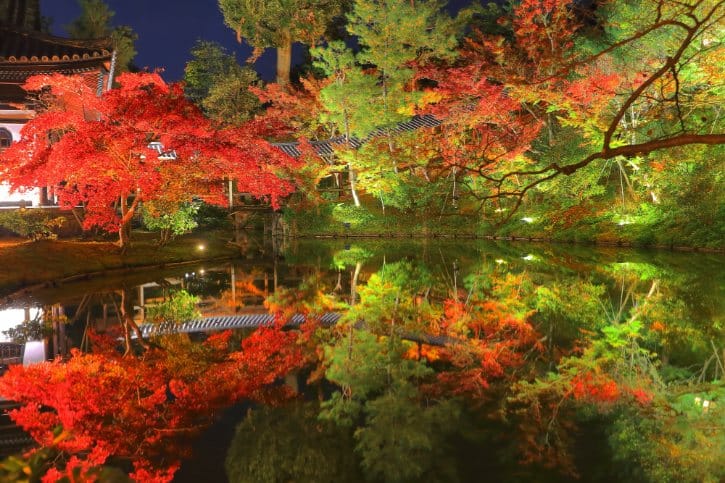
- Special Night Events: Temple gardens and buildings beautifully lit during spring (cherry blossoms) and autumn (maple leaves). Includes creative lighting and projections, making gardens feel magical at night.
f. Walk Nene’s Path (Nene-no-Michi)
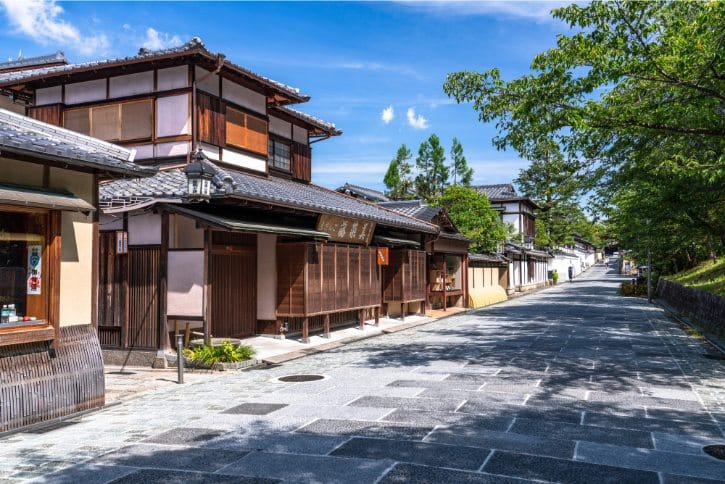
- Historic Walking Street: Charming pedestrian road lined with traditional buildings, shops, and cafes, connecting Kodaiji with nearby Kiyomizudera temples and Yasaka Pagoda. Ideal for photos and soaking up old Kyoto’s atmosphere.
g. How to Get There
- Option 1: Take Kyoto City Bus #86, #202 or #206 to Kiyomizumichi bus stop, then walk about 7 minutes to Kodaiji Temple.
- Option 2: Take Kyoto City Bus #202, #206 or #207 to Higashiyama Yasui bus stop, then walk about 7 minutes to Kodaiji Temple.
Read More: Kyoto Itinerary: Your Best 3 Days Travel Guide
8. Kurama-dera Temple (Kyoto)
a. Overview
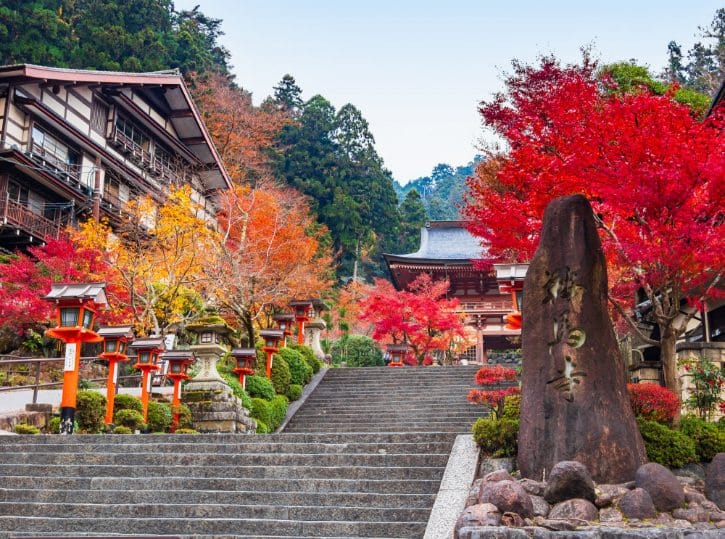
- What It Is: Kurama-dera is a peaceful Buddhist temple located on Mount Kurama, north of Kyoto, surrounded by forests and mountains.
- History: Founded in 770 CE, the temple is famous as a spiritual site where samurai hero Minamoto no Yoshitsune supposedly trained. It became independent with its unique deities (Sonten) in 1949.
- Why Visit: Great for a mix of nature, history, and spirituality. You’ll enjoy scenic hikes, ancient shrines, and panoramic views.
- Atmosphere: Quiet, spiritual, and calming. Expect cedar forests, fresh mountain air, and fewer crowds compared to central Kyoto temples.
b. Arrival & First Impressions
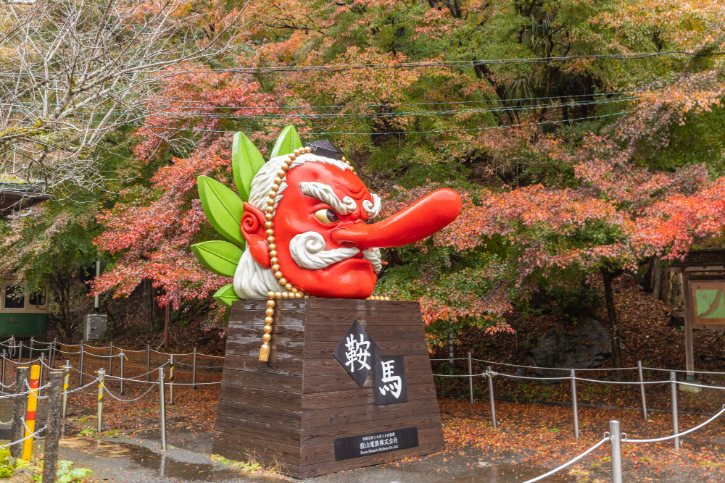
- Giant Daitengu Sculpture at Kurama Station: Take a quick photo with the large red goblin sculpture near the station entrance, symbolizing mountain spirits.
c. Getting Up the Mountain
- Cable Car (Funicular Railway): From Niomon Gate, pay ¥500 admission. Then take a short cable car ride halfway up the mountain for ¥200 one-way. It saves energy and offers a nice view.
- Hiking Trail: If you prefer hiking, take the scenic trail instead. It’s a 30–45-minute climb through cedar forests and past shrines. The path is steep, so wear comfortable shoes and rest on benches if needed.
d. Exploring the Temple Grounds
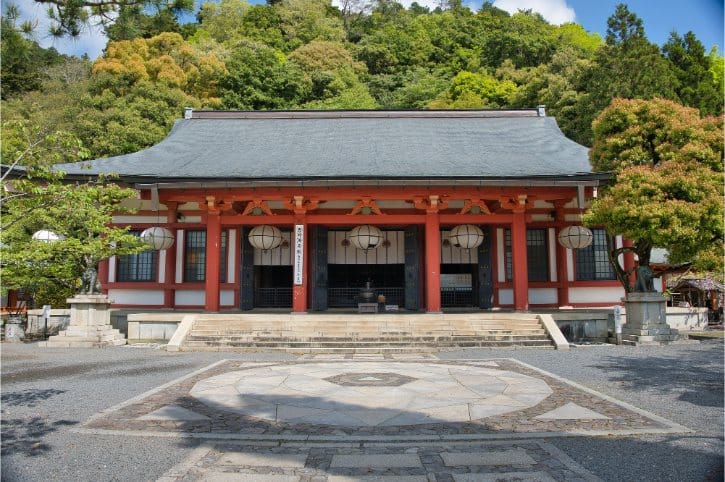
- Main Hall (Honden): The central temple hall houses special statues and offers beautiful mountain views from its terrace.
- Kongoshō Hexagram: Stand on the six-pointed star in front of the Main Hall. It’s considered a powerful spiritual spot, perfect for quiet reflection.
- Kuramayama Reihoden Museum: Small museum near the Main Hall with historical items and temple artifacts.
- Okuno-in Maoden (Inner Sanctuary): About 10–15 minutes beyond the Main Hall, visit this peaceful shrine dedicated to the unique deity Maōson (a deity from Venus).
e. Nearby Attractions and Relaxation
- Kurama Onsen (Hot Spring): Relax after your visit at this nearby hot spring, offering both indoor and outdoor baths (¥2,500–¥2,700). A free shuttle bus is available or you can walk there in 10 minutes from the station.
- Yuki Shrine: Located halfway up the mountain, stop at this small shrine known for its huge, 800-year-old cedar tree and the Kurama Fire Festival held each October.
f. How to Get There
- From Kyoto Station, take the JR Nara Line to Tofukuji Station (2 minutes, 150 yen).
- At Tofukuji Station, transfer to the Keihan Main Line towards Demachi-Yanagi Station (17 minutes, 280 yen).
- At Demachi-Yanagi, switch to the Eizan Railway Kurama Line and ride to Kurama Station (30 minutes, 470 yen).
- Upon exiting Kurama Station, you’ll notice the Mount Kurama Daitengu Sculpture on your left.
- From there, it’s a short 5-minute walk to the temple’s main entrance (Niomon Gate).
- After entering, you have two options:
- Take the cable car from Sanmon Station (200 yen one-way), or
- Hike up the mountain path, about 30–45 minutes.
9. Kennin-ji Temple (Kyoto)
a. Overview
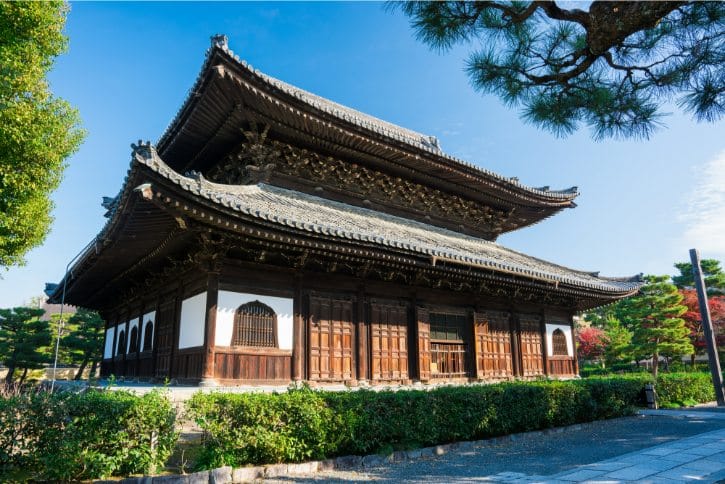
- What It Is: Kennin-ji is Kyoto’s oldest Zen temple, built in 1202. It’s known for Zen gardens, historic art, and calm surroundings.
- History: Founded by Monk Eisai, who brought Zen Buddhism and green tea culture from China. It’s one of Kyoto’s major Zen temples.
- Why Visit: Perfect place for relaxation away from city noise. Offers famous artworks like the Twin Dragons painting and Zen gardens.
- Atmosphere: Quiet, peaceful, and usually uncrowded despite being near busy Gion. Visitors often whisper to keep the serene mood. You’ll hear sounds like gravel footsteps or leaves rustling.
b. Art & Architecture
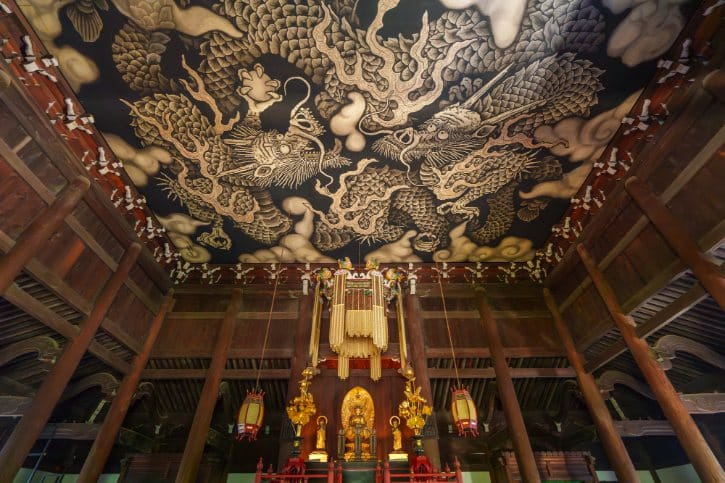
- Twin Dragons Ceiling: Huge ink painting on Dharma Hall ceiling, created for temple’s 800th anniversary in 2002. Impressive and popular for photos.
- Wind & Thunder Gods Screen: High-quality replica of famous gold-leaf painting showing two dramatic gods (original is in Kyoto National Museum).
- Sliding Door Paintings at Hojo Hall: Historic artwork painted about 400 years ago featuring landscapes and dragons scenes. Most are originals, some replicas.
c. Beautiful Zen Gardens
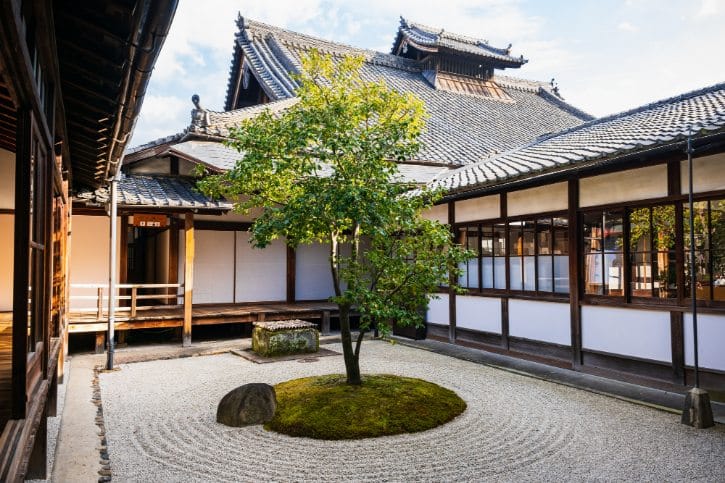
- ○△□ Garden: Small garden with symbolic shapes (circle, triangle, square), representing Zen ideas about nature and universe.
- Garden of the Sound of the Tide: Simple and quiet courtyard garden, with moss and three stones representing Buddha and attendants. Designed for peaceful reflection.
- Daio-en Garden: Largest Zen rock garden at Kennin-ji, representing mountains and clouds. Sit on the veranda to fully enjoy the peaceful view.
d. How to Get There
- By Train: Take the Keihan Main Line to Gion-Shijo Station, use Exit 1, then walk about 9 minutes to Kennin-ji Temple.
- By Bus:
- Take Kyoto City Bus #80, #86 or #207 to Kiyomizu-michi bus stop, then walk about 5 minutes to Kennin-ji Temple.
- Take Kyoto City Bus #86, #106, #202 or #206 to Kiyomizumichi bus stop, then walk about 4 minutes to Kennin-ji Temple.
10. Amanohashidate (Kyoto)
When you visit Amanohashidate in Kyoto, you’ll discover one of Japan’s most beautiful sights. It’s a long sandbar covered with pine trees.
You can see the famous upside-down view at two places.
Kasamatsu Park is on the north side and offers peaceful scenery. Viewland is on the south side and has great views along with fun rides for families.
i. Amanohashidate Kasamatsu Park
a. Overview
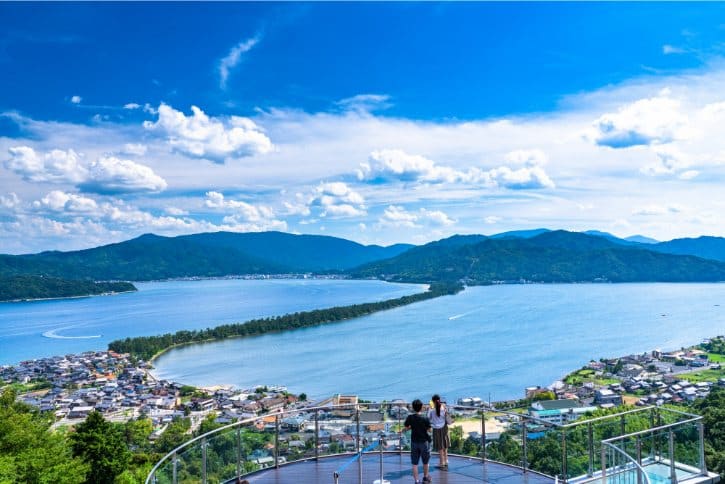
- What It Is: A scenic hilltop park overlooking Amanohashidate, one of Japan’s three most famous views. Located on the north side of the sandbar in Kyoto Prefecture, accessible by cable car or chairlift.
- History: Amanohashidate means “bridge to heaven”, based on an old legend. The area has been admired for centuries, and Kasamatsu Park is one of the best-known places to see it.
- Why Visit: It offers stunning panoramic views and unique local activities like the famous upside-down viewing experience (“Matanozoki”).
- Atmosphere: Peaceful, family-friendly, and welcoming. Quiet with natural surroundings, great for relaxing and photos.
b. Ride the Cable Car or Chairlift
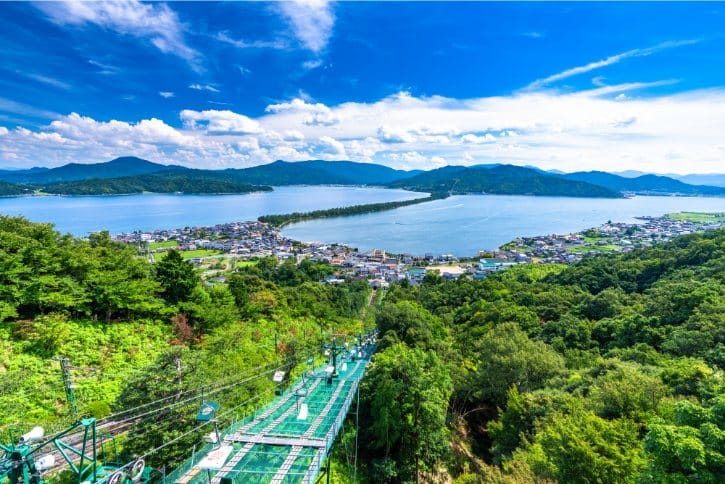
- Cable Car: Covered, enclosed, good for rainy days or families. Takes about 4-minute.
- Chairlift: Open-air seats, great for photos and fresh air, ride lasts about 6- minute. It’s recommended to take the chairlift down the hill for the best views of Amanohashidate. You can use the cable car on the way up.
c. Circular Sky Deck & Viewing Platforms
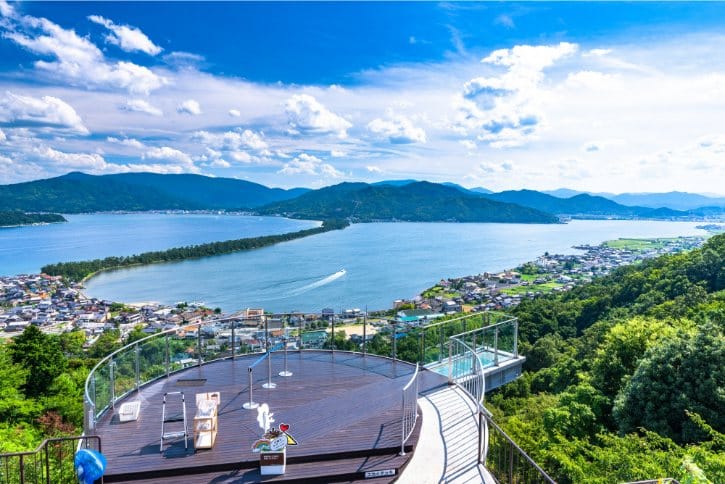
- Sky Deck: Round wooden deck with glass flooring, best for panoramic views and photos.
- Other Platforms: Multiple wooden viewing decks offering different perspectives of Amanohashidate.
- Best Time: Late morning to mid-afternoon. Spring (cherry blossoms) and autumn (colorful leaves) are particularly beautiful.
d. Try the Famous “Matanozoki” View
- What It Is: Traditional upside-down viewing method – bend forward and look at the scenery through your legs.
- Why Do It: Makes the Amanohashidate sandbar appear like it’s floating in the sky (“flying dragon” view).
e. Kawarake Nage (Clay Disc Throwing)
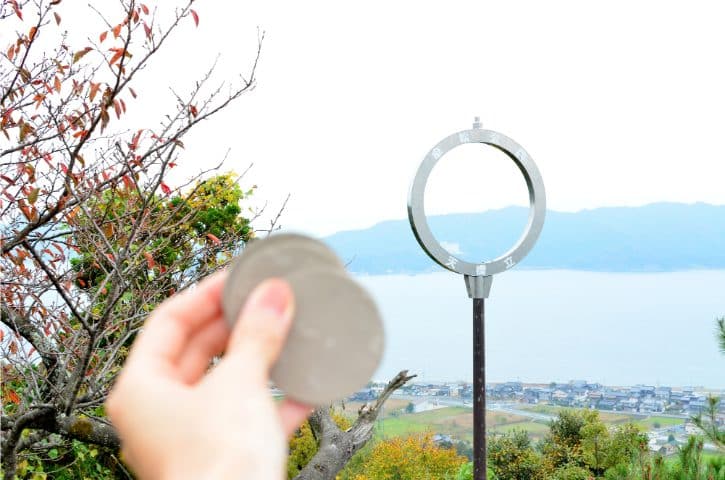
- Activity: Throw clay discs through a target hoop (“Chie-no-wa”) down the hill for good luck.
- Cost: ¥200 for three discs.
- Tips: Aim gently just above the hoop; enjoyable whether you hit or miss.
f. Visit Ama Terrace for Food & Souvenirs
- Restaurant (2nd Floor): Offers local seafood dishes, rice bowls, noodles, and curry. Great views while dining.
- Café (1st Floor): Snacks like local Kasamatsu dango (sweet rice dumplings), grilled pork sausage, coffee, and ice cream.
- Souvenirs: Local specialties like snacks, sake, sweets, crafts, and park-themed gifts. Good spot to rest and shop.
g. How to Get to Amanohashidate Kasamatsu Park from Kyoto Station
- Train from Kyoto Station to Amanohashidate Station
- Take the JR Hashidate Limited Express from Kyoto Station directly to Amanohashidate Station.
- Journey Duration: About 2 hours and 10 minutes.
- Fare: About ¥4,800 – ¥5,000 one-way, depending on your travel date.
- From Amanohashidate Station to Kasamatsu Park Cable Car/Chairlift Station (Fuchu Station)
- Option A: By Bus
- Exit Amanohashidate Station.
- Board the Tankai Bus bound for Ine/Hioki.
- Alight at the “Amanohashidate Cable-shita” bus stop.
- Bus Duration: About 26 minutes.
- Walking Duration: About 3 minutes from “Amanohashidate Cable-shita” bus stop to cable car/chairlift station.
- Option B: By Sightseeing Boat
- Walk from Amanohashidate Station to Amanohashidate Pier.
- Take the Amanohashidate Sightseeing Boat to Ichinomiya Ferry Terminal.
- Boat Fare: ¥800.
- Boat Duration: About 12 minutes.
- Walking Duration: About 5 minutes from Ichinomiya Ferry Terminal to cable car/chairlift station.
- Option A: By Bus
- Cable Car/Chairlift to Kasamatsu Park
- Choose either the cable car (4-minute ride) or chairlift (6-minute ride) to reach Kasamatsu Park.
- Round-trip Fare: ¥800 (Adults), ¥400 (Children)
- Recommendation: Take the cable car up and the chairlift down for optimal views.
ii. Amanohashidate Viewland
a. Overview
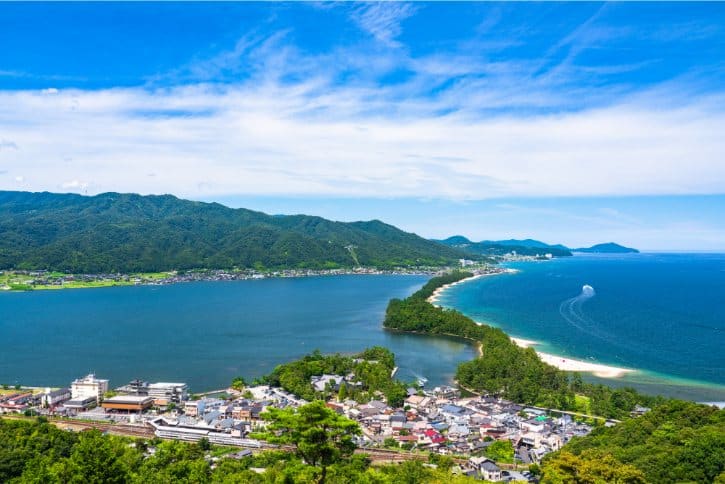
- What It Is: Amanohashidate Viewland is a hilltop park and viewpoint in northern Kyoto (Miyazu City). It’s famous for views of Amanohashidate sandbar, one of Japan’s “Three Scenic Views”, and has a small amusement park.
- History: Opened in 1970 on Mt. Monju to offer a southern viewpoint of Amanohashidate. Previously, most viewing was done from the north.
- Why Visit: Great panoramic views, especially the famous upside-down “Matanozoki” view, where the sandbar looks like a dragon flying through the sky. The combination of scenic beauty and amusement rides makes it unique.
- Atmosphere: Relaxed and family-friendly. Usually calm, not too crowded, with a mix of families, couples, and tour groups. The amusement area feels a bit retro and relaxed.
b. Ride the Monorail or Chairlift
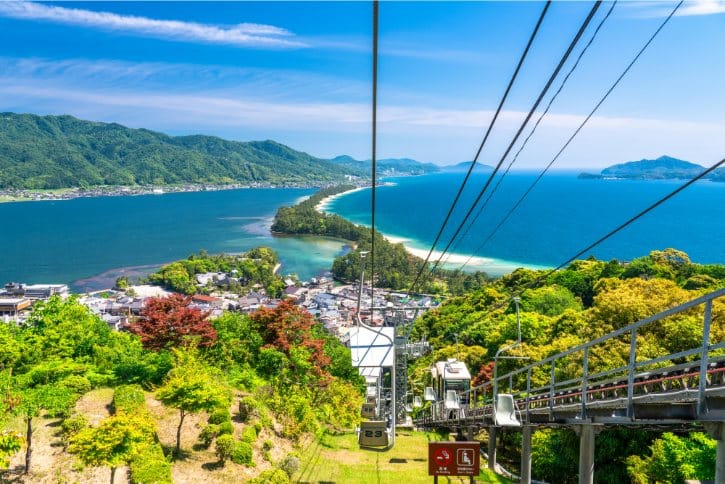
- Chairlift: Open-air, 6-minute ride with scenic views. Recommended to ride down from the top for the best views of Amanohashidate as you descend.
- Monorail (Slope Car): Enclosed, comfortable 7-minute ride, ideal in rain or if you have small children or strollers.
c. Enjoy the Views & Try “Matanozoki”
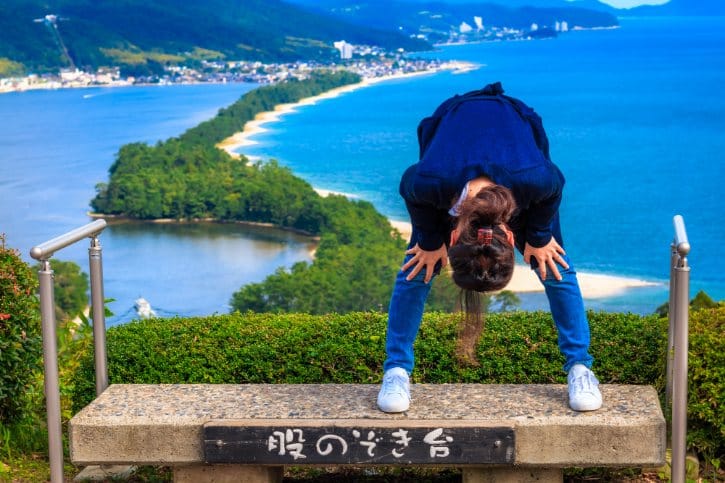
- Matanozoki (Upside-Down Viewing): Stand with your back facing Amanohashidate, bend forward, and look between your legs. This unique view makes the sandbar look like a flying dragon.
- Hiryukan-Kairo Deck: Walk the 250-meter elevated walkway for 360-degree views of Amanohashidate, perfect for leisurely strolling and taking photos.
d. Fun Rides & Activities
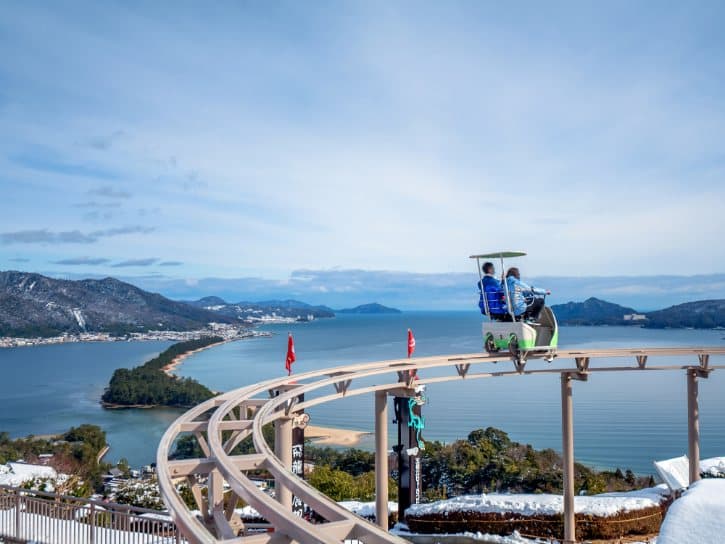
- Cycle Cars (Sky Cycling): Pedal-powered cars on raised rails for fun aerial views; enjoyable for adults and kids alike.
- Ferris Wheel: Small, relaxing Ferris wheel ride offering elevated scenic views.
e. Kawarake-nage (Lucky Pottery Throwing)
- Lucky Pottery Throwing: Buy clay disks (“kawarake”) and toss them through a hoop (the “Wisdom Ring”) for luck. Simple and fun, especially for kids.
f. Family-Friendly Attractions
- Go-Karts: Mini go-kart track, easy to drive and popular with younger kids.
- Merry-Go-Round: Traditional carousel suitable for small children and toddlers.
- Archery & Target Games: Simple archery range and retro-style shooting gallery, fun for older children and adults.
g. How to Get to Amanohashidate Viewland from Kyoto Station
- Train from Kyoto Station to Amanohashidate Station
- Take the JR Hashidate Limited Express from Kyoto Station directly to Amanohashidate Station.
- Journey Duration: About 2 hours and 10 minutes.
- Fare: About ¥4,800 – ¥5,000 one-way, depending on your travel date.
- From Amanohashidate Station to Viewland Monorail/Chairlift Station
- Exit Amanohashidate Station
- Walk about 5 minutes to reach Amanohashidate Chairlift and Monorail Station.
- Monorail/Chairlift to Viewland
- Choose either the monorail (7-minute ride) or chairlift (6-minute ride) to reach Viewland.
- Round-trip Fare: ¥1,000 (Adults), ¥500 (Children).
- Recommendation: Take the monorail up and the chairlift down for best views.
Read More: A Complete Day Trip Guide to Amanohashidate and Ine Funaya from Kyoto or Osaka
Related Posts
Photo Credit:
Photos by PIXTA

